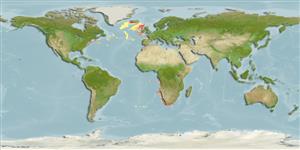Elasmobranquios (tiburones y rayas) (sharks and rays) >
Carcharhiniformes (Ground sharks) >
Pentanchidae (Deepwater catsharks)
Etymology: Apristurus: a-, Latin privative, i.e., without; pristis, from pristes (Gr.), sawyer (but here meaning saw); oura (Gr.), tail, referring to absence of saw-toothed crest of enlarged dermal denticles along upper edge of caudal fin as found in the closely related Pristiurus (=Galeus). (See ETYFish); microps: micro-, from mikros (Gr.), small; ops (Gr.), eye, described as having the smallest eyes in its original genus, Scyliorhinus (Scyliorhinidae). (See ETYFish).
Environment: milieu / climate zone / depth range / distribution range
Ecología
marino batidemersal; rango de profundidad 1000 - 2200 m (Ref. 55584). Deep-water; 67°N - 38°S
Southeast Atlantic: off the Orange River to Cape Agulhas, South Africa. Elsewhere known from the North Atlantic.
Tamaño / Peso / Age
Maturity: Lm ? range ? - ? cm
Max length : 61.0 cm TL macho / no sexado; (Ref. 5578); 43.2 cm TL (female)
Short description
Claves de identificación | Morfología | Morfometría
Espinas dorsales (total) : 0; Espinas anales: 0. A stout, plain catshark with small eyes, a long thick and broad snout, and long labial furrows; mouth projecting well in front of eyes; pectoral fins very short (Ref. 5578). Uniformly black or dark to medium brown or grey; no markings (Ref. 5578).
Found on the continental slope, on or near the bottom (Ref. 244). Feeds on small bony fish, shrimp, squid, and possibly other sharks (Ref. 5578). Oviparous (Ref. 50449).
Life cycle and mating behavior
Maturities | Reproducción | Spawnings | Egg(s) | Fecundities | Larva
Oviparous (Ref. 5578). Embryos feed solely on yolk (Ref. 50449).
Compagno, L.J.V., 1984. FAO Species Catalogue. Vol. 4. Sharks of the world. An annotated and illustrated catalogue of shark species known to date. Part 2 - Carcharhiniformes. FAO Fish. Synop. 125(4/2):251-655. Rome: FAO. (Ref. 244)
IUCN Red List Status (Ref. 130435)
Threat to humans
Harmless
Human uses
Pesquerías: sin interés
Herramientas
Special reports
Download XML
Fuentes de Internet
Estimates based on models
Preferred temperature (Ref.
123201): 3 - 6.1, mean 3.7 °C (based on 57 cells).
Phylogenetic diversity index (Ref.
82804): PD
50 = 0.5000 [Uniqueness, from 0.5 = low to 2.0 = high].
Bayesian length-weight: a=0.00355 (0.00176 - 0.00714), b=3.09 (2.91 - 3.27), in cm total length, based on LWR estimates for this (Sub)family-body shape (Ref.
93245).
Nivel trófico (Ref.
69278): 3.8 ±0.3 se; based on diet studies.
Resiliencia (Ref.
120179): Muy bajo, población duplicada en un tiempo mínimo superior a 14 años (Fec assumed to be <10).
Fishing Vulnerability (Ref.
59153): Moderate vulnerability (44 of 100).
Nutrients (Ref.
124155): Calcium = 10.9 [1.9, 65.3] mg/100g; Iron = 0.36 [0.08, 1.25] mg/100g; Protein = 18.7 [16.6, 20.9] %; Omega3 = 0.249 [0.094, 0.654] g/100g; Selenium = 16.7 [5.1, 56.2] μg/100g; VitaminA = 6.45 [1.27, 30.69] μg/100g; Zinc = 0.319 [0.159, 0.597] mg/100g (wet weight);
